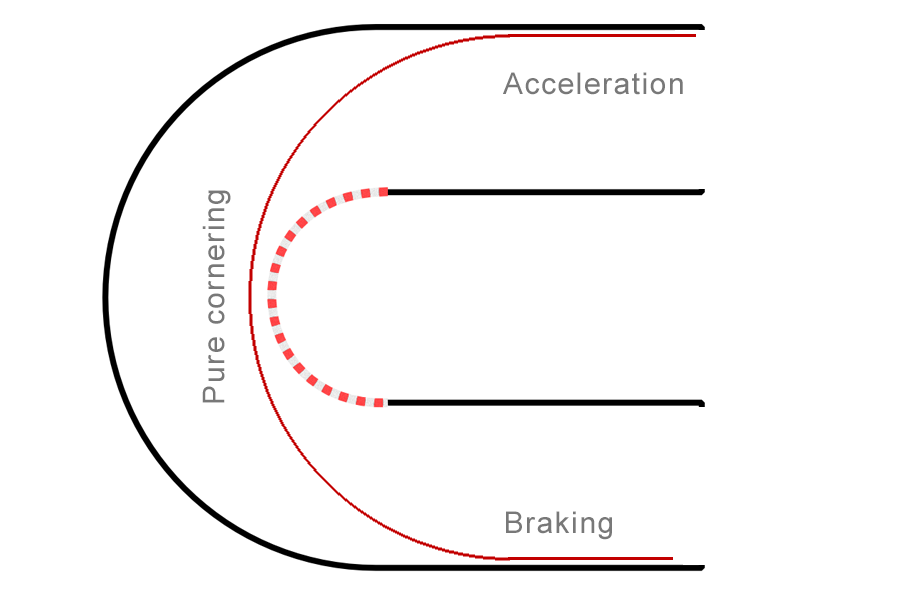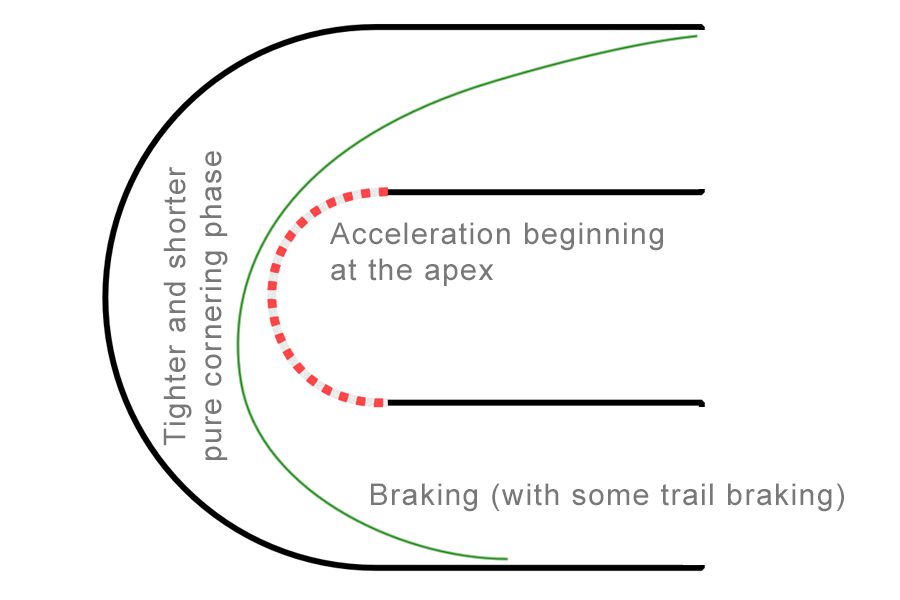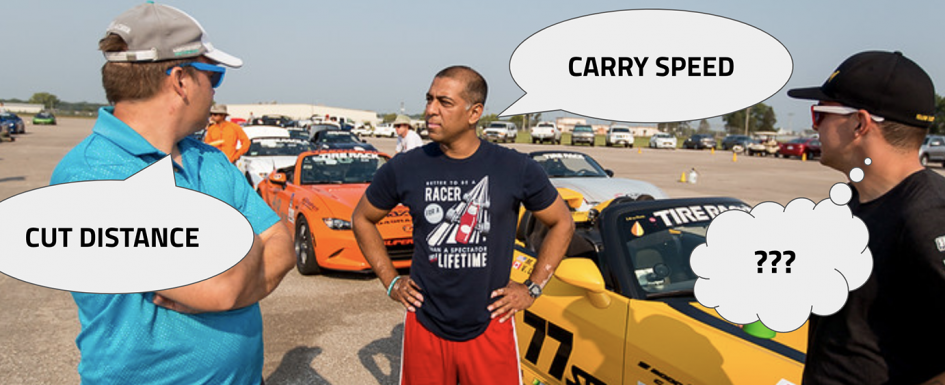When it comes to figuring out the racing line, we often hear conflicting advice. We hear autocrossers preach the mantra of cutting distance above all else, while track drivers, as well as most racing education material, talk about using “all of the track” to carry more speed.
Who is right? Are the rules different for autocross and track driving?
Spoiler alert: The rules for determining the optimal line are identical for autocross and higher speed track driving. But in order to uncover what’s going on, we need some context. We need to uncover the origins of some of the common hand-me-down advice, and understand why they are wrong, or rather, incomplete.
The line, as described to beginners
The first piece of advice given to novice drivers about the racing line is usually to “use all of the track”, and it is represented in diagrams with the largest perfectly circular arc drawn through the corner.

This is a fine place to start, but is nowhere near the fastest way around the corner. It is important to understand that this is the advice given to novice drivers for 2 reasons. First, It is easy to explain. It is meant to be a way to get drivers used to the idea of using the available space to carry speed, and finding and staying on the limit of grip. Second, it is easy to execute because it does not require advanced car control skills, which makes it safer for a beginner. The nature of driving this line is that the driver will always only be doing one thing at a time… braking, cornering, accelerating… those will happen with minimal overlap when using this line. What’s important to understand here is that this line is not used by any competitive driver. It is just a training tool used to communicate the idea of using more space on the track.
The line, as described to intermediate drivers
As we progress to an intermediate level, we are taught to use a later apex, and to blend getting on the gas with unwinding the steering wheel.

This, by definition, requires a tighter initial corner radius, so that we have room for our arc to grow larger as we accelerate out of the corner. We are also taught to brake later and deeper in order to facilitate the late apex line. Inevitably, every developing driver will push this too far and go through a phase where they brake too late, go too deep into corners, and apex too late. But over time, as our judgment and car control skills improve, we are able to nail the corner exits most of the time with controlled aggression.
As we progress, we begin to experiment with trail braking, because that’s what the really fast drivers do. It may be tricky at first, but with practice, we get better at it, and see some time improvements, but the best drivers still seem to be a bit out of reach. At this stage of development, the driver is very comfortable with car control and being on the correct line on corner exit, but still struggles with consistency and outright pace on corner entry.
And that’s all we were ever taught, until now!
Most driver education books, courses, etc. are targeted towards the novice and intermediate drivers, so this is where the discussion usually ends. This is why most drivers, even those who have been competing for decades, continue to use these beginner or intermediate lines and techniques; they have never been taught anything different! Most books or videos describe the corner entry portion as being a compromised part of the corner, where we drive a less than ideal arc in order to set up for the exit. That’s well and good from a beginner’s perspective because it is easy to explain and safe to execute. It has only been in the last few years that books and courses have emerged that expose the secrets of corner entry.
The idea that what we have been taught is wrong, and is NOT actually the fastest way around a corner, may be very jarring for some of you. It goes against everything we have heard in the past. We’ve built an entire system around what we have been taught and believe to be true! It is how we arrived at our current driving style, and it has informed how we set up our race cars. There is a natural resistance we feel when someone introduces new information that shakes our fundamental beliefs. We see this happen all the time in our lives where we notice people seemingly clinging to what they have believed to be true, even in the face of overwhelming evidence to the contrary. But the fact remains, if maximum performance is what you are looking for, you will not find it on those lines.
If you are still a skeptic, I recommend watching videos of any top level F1 or GT driver and notice the lines that the fastest drivers drive.
So, what is the right line??
That is one of the many subjects we will be going over in painstaking detail in The Complete Autocrosser’s Manual. We’ll cover a lot of ground…
- Line Selection
- Fundamentals of distance vs. speed
- When and why it is worth adding distance
- Optimizing a single corner (this is where we will go over the secrets of corner entry)
- Reading and optimizing an autocross course
- The Physics of Driving
- Looking and thinking ahead
- Car control
- How the rules change for different types of cars
- Driving in the rain
- Shuffle steering? Left foot braking?
- Improving Execution
- Analyzing our execution and our game plan
- Dealing with mistakes as soon as they happen and minimizing their effects
- Determining your approach for a 3-run event
- Mental Side of Performance
- Expectations and nervousness
- Performing under pressure
- What to pay attention to when riding along with other drivers
- Post event analysis & using video and data
If you are more of a reader and prefer getting your information from books, I recommend “Driving on the Edge” by Michael Krumm, “Going Faster” by Skip Barber, “The Perfect Corner” by Paradigm Shift Racing, and “Physics For Gearheads” by Randy Beikmann.


The way it was explained to me is that a car travels fastest in a straight line; one therefor wants to extend the straight as much as possible on braking, and start accelerating into the next as early as possible.
Variables such as lack of horsepower inevitably mean compromises!
Stuart, sure, that’s true. But there is much more nuance to it that that :). For instance, what does extending the straight as much as possible mean? Does it mean braking late and as hard as possible in a straight line? Does it mean trail braking? When do you begin turning in? Where do you set the apex? And so on. In the course I am about to release, we will establish rules for how to figure all of that out for different corners.
For sure, the actual line will be different for different cars and different corners, but the RULES for how we figure out the line remain the same 😉
Very intriguing and well written, as always. I assume you’re eluding to baristochrone or euler ?
I am indeed! But to be clear, the point is not for us to blindly drive a certain line/shape. I want to make sure we all understand WHY a spiral line is beneficial, and HOW to apply that to the entry and exit of all types of corners.
Hoo boy, can I used baristochrone curves when braking from 140+?? just when I thought I’d read everything about going faster.
http://mathworld.wolfram.com/BrachistochroneProblem.html.
Bob, the point is not to use a baristochrone curve or euler spiral starting from whatever you speed you may be at. If you are at 140 mph going into a 100 mph corner, maybe you can indeed use the curve/spiral when braking from 140. If you are at 140 mph and entering a 40 mph corner, there will absolutely be a significant straight line braking period before you can initiate the curve/spiral.
As I mentioned above, this is not about blindly applying a particular line/shape. It is about establishing the rules that allow us to take all of the factors into account, and arrive at the right decision for our car’s capabilities, the surface, our speed, the shape/size of the corner, etc.
The manual name aludes to it being more directed at autocrossers. Is it aimed at that kind of driving only or is it just more general advice concerning the racing line overall? I know the concept should still apply, wether its track or autox but if it spends half its content talking about pin point details about autox it might not be for me, but otherwise I guess I should consider it? I have already read Going faster, Driving on the edge, the perfect corner and ultimate secrets of speed (Ross Bentley), if that helps in figuring out where I am regarding theory (I still need many more hours of track time, Im capable of good laps but very unreliable and not able to produce them at will, they just happen sometimes).
Victor, while I would love to take your money right now, frankly… I don’t think this course would be a good fit for your needs. As you said, the overall concepts apply to ALL forms of motorsports, but the information in this course is definitely tailored for autocross specifically.
In a couple of months (around March/April), I plan to release a version of this course that is more attuned to track/circuit racing. I recommend waiting for that one.
Thanks, I will be waiting for that and reading whatever you publish in the meantime then.